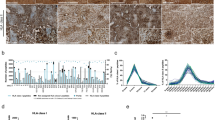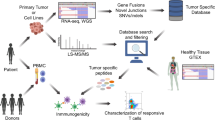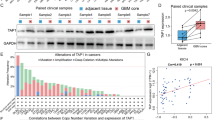Abstract
Objectives We evaluated and compared tumor antigen precursor protein (TAPP) profiles in adult and pediatric brain tumors of 31 genes related to tumor associated antigens (TAA) for possible use in immunotherapy. Antigens were selected based on their potential to stimulate T cell responses against tumors of neuroectodermal origin. Methods Thirty-seven brain tumor specimens from 11 adult and 26 pediatric patients were analyzed by quantitative real-time PCR for the relative expression of 31 TAPP mRNAs. The age range of adults (4F:7M) was 27–77 years (median 51.5 ± 14.5 years) and for pediatrics (12F:14M) was 0.9–19 years (median 8.3 ± 5.5 years). Histological diagnoses consisted of 16 glioblastomas, 4 low grade astrocytomas, 10 juvenile pilocytic astrocytomas, and 7 ependymomas. Results The adult gliomas expressed 94% (29 of 31) of the TAPP mRNAs evaluated compared with pediatric brain tumors that expressed 55–74% of the TAPP mRNAs, dependent on tumor histological subtype. Four types of TAPP expression patterns were observed: (1) equal expression among adult and pediatric cases, (2) greater expression in adult than pediatric cases, (3) expression restricted to adult GBM and (4) a random distribution. The pediatric brain tumors lacked expression of some genes associated with engendering tumor survival, such as hTert and Survivin. Conclusions The potential TAA targets identified from the TAPP profiles of 31 genes associated with adult and pediatric brain tumors may help investigators select specific target antigens for developing dendritic cell- or peptide-based vaccines or T cell-based immunotherapeutic approaches against brain tumors.




Similar content being viewed by others
References
CBTRUS (2005) Statistical report: primary brain tumors in the United States, 1998–2002. In: Central Brain Tumor Registry of the United States. CBTRUS, Chicago, IL, USA
Watson GA, Kadota RP, Wisoff JH (2001) Multidisciplinary management of pediatric low-grade gliomas. Semin Radiat Oncol 11:152–162
Plautz GE, Barnett GH, Miller DW, Cohen BH, Prayson RA, Krauss JC, Luciano M, Kangisser DB, Shu S (1998) Systemic T cell adoptive immunotherapy of malignant gliomas. J Neurosurg 89:42–51
Fakhrai H, Shawler DL, Gjerset R, Naviaux RK, Koziol J, Royston I, Sobol RE (1995) Cytokine gene therapy with interleukin-2-transduced fibroblasts: effects of IL-2 dose on anti-tumor immunity. Hum Gene Ther 6:591–601
Sloan AE, Dansey R, Zamorano L, Barger G, Hamm C, Diaz F, Baynes R, Wood G (2000) Adoptive immunotherapy in patients with recurrent malignant glioma: preliminary results of using autologous whole-tumor vaccine plus granulocyte-macrophage colony-stimulating factor and adoptive transfer of anti-CD3-activated lymphocytes. Neurosurg Focus 9(6):e9
Okada H, Lieberman FS, Edington HD, Witham TF, Wargo MJ, Cai Q, Elder EH, Whiteside TL, Schold SC, Pollack IF (2003) Autologous glioma cell vaccine admixed with interleukin-4 gene transfected fibroblasts in the treatment of recurrent glioblastoma: preliminary observations in a patient with a favorable response to therapy. J Neurooncol 64:13–20
Fakhrai H, Mantil JC, Liu L, Nicholson GL, Murphy-Satter CS, Ruppert J, Shawler DL (2006) Phase I clinical trial of a TGF-β antisense-modified tumor cell vaccine in patients with advanced glioma. Cancer Gene Ther 13:1052–1060
Quattrocchi KB, Miller CH, Cush S, Bernard SA, Dull ST, Smith M, Gudeman S, Varia MA (1999) Pilot study of local autologous tumor infiltrating lymphocytes for the treatment of recurrent malignant gliomas. J Neurooncol 45:141–157
Kruse CA, Cepeda L, Owens B, Johnson SD, Stears J, Lillehei KO (1997) Treatment of recurrent glioma with intracavitary alloreactive cytotoxic T lymphocytes and interleukin-2. Cancer Immunol Immunother 45:77–87
Kruse CA, Rubinstein D (2001) Cytotoxic T-lymphocytes reactive to patient major histocompatibility complex proteins for therapy of brain tumors. In: Liau LM, Becker DP, Cloughesy TF, Bigner DD (eds) Brain tumor immunotherapy. Humana Press, Totowa, NJ, pp 149–170
Plautz GE, Miller DW, Barnett GH, Stevens GHJ, Maffett S, Kim J, Cohen PA, Shu S (2000) T cell adoptive immunotherapy of newly diagnosed gliomas. Clin Cancer Res 6:2209–2218
Yu JS, Liu G, Ying H, Yong WH, Black KL, Wheeler CJ (2004) Vaccination with tumor lysate-pulsed dendritic cells elicits antigen-specific, cytotoxic T-cells in patients with malignant glioma. Cancer Res 64:4973–4979
Liau LM, Prins RM, Kiertscher SM, Odesa SK, Kremen TJ, Giovanone AJ, Lin J-W, Chute DJ, Mischel PS, Cloughesy TF, Roth MD (2005) Dendritic cell vaccination in glioblastoma patients induces systemic and intracranial T-cell responses modulated by the local central nervous system tumor microenvironment. Clin Cancer Res 11:5515–5525
Kikuchi T, Akasaki Y, Irie M, Homma S, Abe T, Ohno T (2001) Results of a phase I clinical trial of vaccination of glioma patients with fusions of dendritic and glioma cells. Cancer Immunol Immunother 50:337–344
Rutowski S, De Vleeschouwer S, Kaempgen E, Wolff JEA, Kuhl J, Demaerel P, Warmuth-Metz M, Flamen P, van Calenbergh F, Plets C, Sorensen N, Opitz A, van Gool SW (2004) Surgery and adjuvant dendritic cell-based tumour vaccination for patients with relapsed malignant glioma, a feasibility study. Br J Cancer 91:1656–1662
Kim CH, Woo SJ, Park JS, Kim HS, Park MY, Park SD, Hong YK, Kim TG (2007) Enhanced antitumour immunity by combined use of temozolomide and TAT-survivin pulsed dendritic cells in a murine glioma. Immunology 122:615–622
De Vleeschouwer S, Rapp M, Sorg RV, Steiger H-J, Stummer W, van Gool S, Sabel M (2006) Dendritic cell vaccination in patients with malignant glioma: current status and future directions. Neurosurgery 59:988–1000
Zhang JG, Eguchi J, Kruse CA, Gomez GG, Fakhrai H, Schroter S, Ma W, Hoa N, Minev B, Delgado C, Wepsic HT, Okada H, Jadus MR (2007) Antigenic profiling of glioma cells to generate allogeneic vaccines or dendritic cell-based therapeutics. Clin Cancer Res 13:566–575
Kleihues P, Cavenee WK (eds) (2000) World health organization of tumours. Pathology and Genetics of Tumours of the Nervous System. IARC Press, pp 10–30
Pfaffl MW (2001) A new mathematical model for relative quantification in real-time RT-PCR. Nucleic Acids Res 29:e45
Saikali W, Avril T, Collet B, Hamlat A, Bansard J-Y, Drenou B, Guegan Y, Quillien V (2007) Expression of nine tumour antigens in a series of human glioblastoma multiforme: interest of EGFRvIII, IL-13Rα2, gp100 and TRP-2 for immunotherapy. J Neurooncol 81:139–148
Okano F, Storkus WJ, Chambers WH (2002) Identification of a novel HLA-A* 0201 restricted cytotoxic T lymphocyte epitope inhuman glioma-associated antigen, interleukin-13 receptor α2 chain. Clin Cancer Res 8:2851–2855
Kelland L (2007) Targeting the limitless replicative potential of cancer: the telomerase/telomere pathway. Clin Cancer Res 13:4960–4963
Boldrini L, Pistolesi S, Gisfredi S, Ursino S, Ali G, Pieracci N, Basolo F, Parenti G, Fontanini G (2006) Telomerase activity and hTERT mRNA expression in glial tumors. Int J Oncol 28:1555–1560
Kajiwara Y, Yamasaki F, Hama S, Yahara K, Yoshioka H, Sugiyama K, Arita K, Kurisu K (2003) Expression of survivin in astrocytic tumors: correlation with malignant grade and prognosis. Cancer 97:1077–1083
Liu X, Chen N, Wang X, He Y, Chen X, Huang Y, Yin W, Zhou Q (2006) Apoptosis and proliferation markers in diffusely infiltrating astrocytomas: profiling of 17 molecules. J Neuropathol Exp Neurol 65:905–913
Fangusaro JR, Caldas H, Jiang Y, Altura RA (2006) Survivin: an inhibitor of apoptosis in pediatric cancer. Pediatr Blood Cancer 47:4–13
Aidida C, Berrebi D, Peucdhmaur M, Reyes-Mugica M, Altieri DC (1998) Anti-apoptosis gene, survivin, and prognosis of neuroblastoma. Lancet 351:882–883
Islam A, Kageyama H, Takada N, Kawamoto T, Takayasu H, Isogai E, Ohira M, Hashizume K, Kobayashi H, Kaneko Y, Nakagawara A (2000) High expression of survivin, mapped to 17q25, is significantly associated with poor prognostic factors and promotes cell survival in human neuroblastoma. Oncogene 19:617–623
Fangusaro JR, Jian Y, Holloway MP, Caldas H, Singh V, Boue DR, Hayes J, Altura RA (2005) Survivin, Survivin-2B and Survivin-deltaEx32 expression in medulloblastoma: biologic markers of tumour morphology and clinical outcome. Br J Cancer 92:359–365
Pinol-Roma S, Swanson MS, Gall JG, Dreyfuss G (1989) A novel heterogeneous nuclear RNP protein with a unique distribution on nascent transcripts. J Cell Biol 109:2575–2587
Shih SC, Claffey KP (1999) Regulation of human vascular endothelial growth factor mRNA stability in hypoxia by heterogeneous nuclear ribonucleoprotein L. J Biol Chem 274:1359–1365
Newcomb EW, Ali MA, Schnee T, Lukyanov Y, Fowkes M, Miller DC, Zagzag D (2005) Flavopiridol downregulates hypoxia-mediated HIF-1a expression in human glioma cells by a proteasome-independent pathway: implications for in vivo therapy. Neuro Oncol 7:225–235
Gagner J-P, Law M, Fischer I, Newcomb EW, Zagzag D (2005) Angiogenesis in gliomas: imaging and experimental therapeutics. Brain Pathol 15:342–363
Tanwar MK, Gilbert MR, Holland EC (2002) Gene expression microarray analysis reveals YKL-40 to be a potential serum marker for malignant character in human glioma. Cancer Res 62:4364–4368
Johansen JS, Jensen BV, Roslind A, Nielsen D, Price PA (2006) Serum YKL-40, a new prognostic biomarker in cancer patients? Cancer Epidemiol Biomarkers Prev 15:194–202
Colin C, Baeza N, Bartoli C, Fina F, Eudes N, Nanni I, Martin P-M, Ouafik L, Figarella-Branger D (2006) Identification of genes differentially expressed in glioblastoma versus pilocytic astrocytoma using Suppression Subtractive Hybridization. Oncogene 25:2818–2826
Acknowledgements
This work was partially supported by a Veterans Affairs Merit Review grant [MRJ], the Long Island League to Abolish Cancer Fund [EWN] and National Institutes of Health grants NS057829 [EWN], NS046463, CA121258, NS054093, NS056300, and The R. Herbert & Alma S. Manweiler Memorial Research Fund [CAK] and the Making Headway Foundation [DZ].
Author information
Authors and Affiliations
Corresponding author
Additional information
Elizabeth W. Newcomb and Martin R. Jadus contributed equally as senior authors.
Electronic supplementary material
Rights and permissions
About this article
Cite this article
Zhang, J.G., Kruse, C.A., Driggers, L. et al. Tumor antigen precursor protein profiles of adult and pediatric brain tumors identify potential targets for immunotherapy. J Neurooncol 88, 65–76 (2008). https://doi.org/10.1007/s11060-008-9534-4
Received:
Accepted:
Published:
Issue Date:
DOI: https://doi.org/10.1007/s11060-008-9534-4




